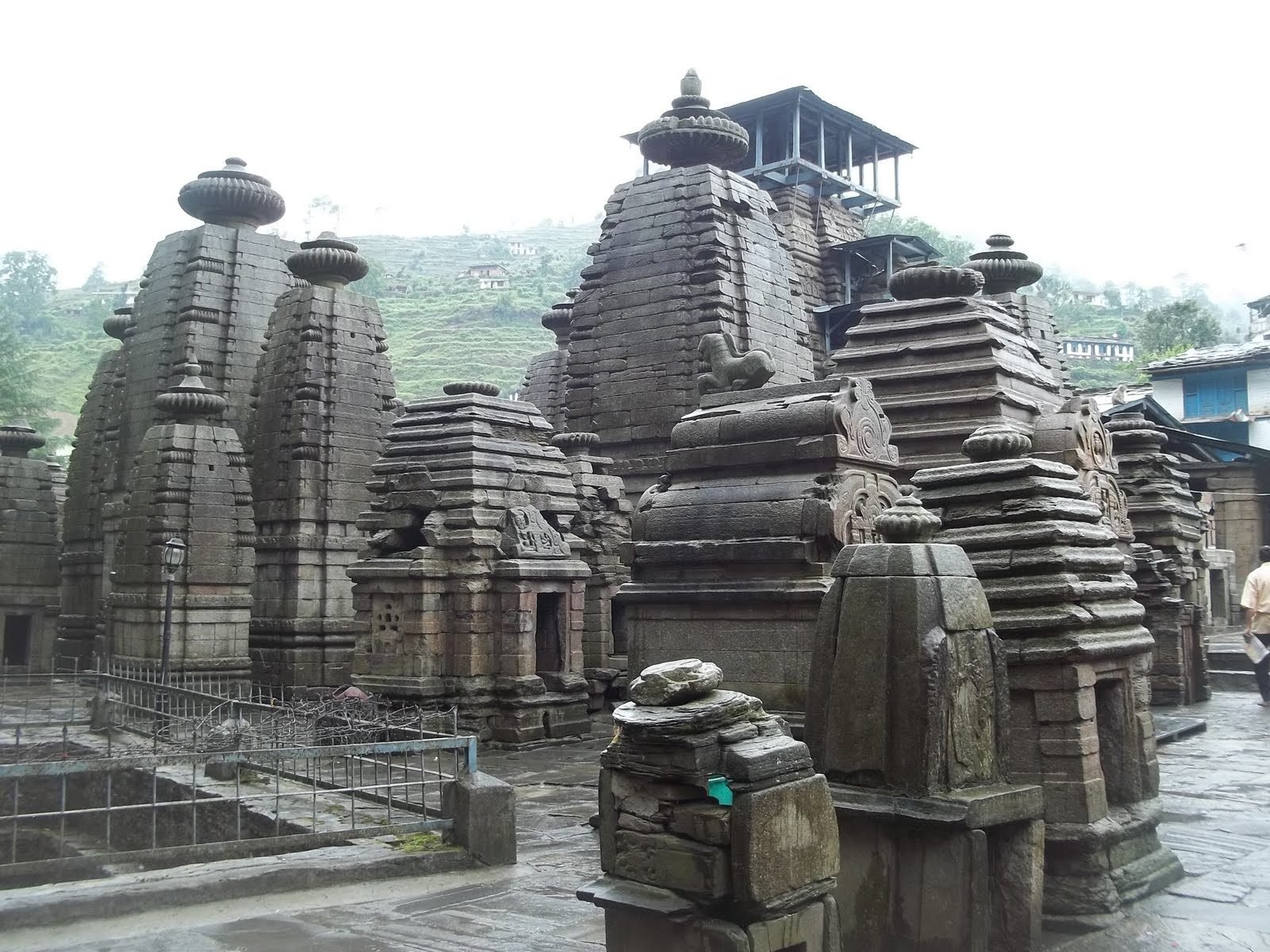The Jageshwar Temples, also known as Jageswar Temples or Jageshwar Valley Temples, are a group of 124 ancient Hindu temples dating from between the 7th and 14th centuries near Almora, in the Indian Himalayan state of Uttarakhand. The valley has several groups of temples, such as the Dandeshwar and Jageshwar sites. Some places have attracted the construction of new temples during the 20th century. Together, these groups above the valley consist of more than 200 structural temples built from carved stone. Many are small, while a few are substantial. They predominantly illustrate the Nagara architectural style of North India with a few exceptions showing South and Central Indian style designs, many are dedicated to the god Shiva, while others in the immediate vicinity are dedicated to the god Vishnu, the goddesses Shakti and Surya traditions of Hinduism.
Jageshwar is a Hindu pilgrimage city and one of the Dhams (pilgrimage region) in the tradition of Shaivism. The site is protected by Indian laws and managed by the Archaeological Survey of India (ASI). It includes the Dandeshwar Temple, the Chandi-ka Temple, the Jageshwar Temple, the Kuber Temple, the Mritunjaya Temple, Nanda Devi or Nau Durga, the Nava-grah Temple, a pyramid shrine, and the Surya Temple. The site celebrates the Jageshwar monsoon festival during the Hindu calendar month of Shravan (overlaps with July-August) and the annual Maha Shivratri Mela (Shivratri festival), which takes place in early spring.
History
The origins of the site of the Jageshwar temples are unclear. Its remote location has limited his studies and academic attention. The site shows evidence of different architectural styles and construction periods for both temples and stone stelae, ranging from the 7th to the 12th century, and then into modern times. Estimates for the same temple or stela vary widely, sometimes 1,400 years. According to the ASI, some belong to the post-Gupta or the second half of the 1st millennium while others belong to the 2nd millennium. Some colonial-era conjectures attribute them to the Katyuri or Chand hill dynasties, but there is no textual or epigraphic evidence to support or refute these proposals. Another prevailing theory is that Adi Shankara built some of these temples, but again there is no textual or epigraphic evidence to support this claim. Instead, the architectural features and style of some of these Hindu temples are from the early 7th century, which is between 50 and 100 years before Adi Shankara (c. 788-820 CE) lived.
The lack of systematic studies of Indian temples and ruins in many parts of the remote Himalayan regions limits what can be said about the chronological sequence of monuments in the Jageshwar Valley. According to Chanchani, the valley likely reached a prominent position in Indian architecture in the 10th century, with the earliest monuments from the 7th century.
The valley has two main groups of Hindu temples and several roadside shrines. Of these, some 151 temples have been numbered by ASI as protected monuments prior to the 12th century. The two largest groups are locally called Dandeshwar group temples (Dandeshwar samuh mandir, 15 temples) and Jageshwar group temples (Jageshwar samuh mandir, 124 temples). Of these, temple numbers 37, 76, and 146 are the largest, all dating from the last centuries of the first millennium. In the historical text, Jageshwar is also known as Yageshvara.
Jageshwar was once the center of Lakulish Shaivism, probably by monks and immigrants who left the plains of the Indian subcontinent from places like Gujarat and settled in the high mountains. [citation needed] The temple site, over time, positioned and grew as sacred geography in the form of the North (Uttara) Kashi (Varanasi).
Description
The Jageshwar group of temples is similar to a large historical group of Hindu temples found in the Indian subcontinent. For example, a similar group is seen near Bhubhaneswar, Odisha in the Lingaraja group of temples. Another large group of stone temples is illustrated in the Batesvar complex in the Chambal valley of Madhya Pradesh. Almost all the small and large temples in the Jageshwar Valley, says Chanchani, have “simple square-plan shrines bounded by smooth walls and stepped superstructures.” Some important monuments in the Jageshwar Valley include:
- Temple 47, located on the site of Jageshwar, is a Valabhi Nagara-style superstructure with a 7th or 8th century chariot vault. Its western wall was crowned with a stele of Vinadhara Shiva (lute with the legend of Shiva, Shaivism), the north wall with a stele of Ganesha (pan-Hindu) and the east wall with yoga interpreting Saptamatrikas (seven mothers, Shaktism tradition) .
- Temple 2, found on the site of Jageshwar, is another early temple with a stepped tower in the curvilinear Latin Nagara style. Its square sanctuary is preceded by a small vestibule (antarala). The platform and base molding resemble Temple 47. The tower is topped with a toothed disk (amalaka) and on top is a hypetral linga. The walls of this temple have niches, while above the door of the sanctuary there is an attic with the three-faced Shiva carved on it. The temple also has a relief carving from the 7th or 8th century that shows Lakulisa sitting on a lotus in the water, in a yoga asana doing meditation where the gods approach her from the heavens and the yogis surround her.
- El Templo 145, que se encuentra en el sitio de Dandeshwar, también es un templo de los siglos VII y VIII, pero exhibe un tercer estilo distinto que sugiere una aceptación y proliferación de la diversidad de artistas. Su torre consta de series apiladas de amalaka en forma de discos dentados de diámetro cada vez menor. Debajo está el santuario cuadrado (garbha griya) cuyo marco de puerta y mandapa están formados por pilares cuadrados. Dentro del lugar sagrado hay un chaturmukha Shiva linga, cada rostro mirando a una dirección cardinal.
- Temple 76, found at the Jageshwar site, is another first millennium temple on the site, but it is substantial. It is dedicated to the Mrityunjaya form of Shiva, or the one who conquered death. The temple is in the middle of smaller lingas and shrines, suggesting their importance when they were built. Temple 76, also called Mrityunjaya Mahadeva temple, is a large temple with Latin Nagara style architecture. It has a four-pillar entrance mandapa, then the mukha-mandapa (main hall) leading to an antarala (vestibule) and then to the square sanctuary. The tower is curvilinear. Its wall is covered with friezes and niches in a format that belongs to 850-950 AD. The temple tower is a multi-story structure, but in the modern era it is covered with a wooden canopy. Inside the canopy is the original amalaka in the form of a toothed disc which is then finished off with a hyperthral linga finial. The Mrityunjaya temple follows the vastupurusha-mandala plane and elevation found in Hindu temple architecture texts. It has 16 central squares like the Hindu Mahua temple, the length of the shrine is equal to the central offset, and the wall thickness is equal to the length of the corner unit, proportions that are taught in the symmetrical 16-grid plan. The temple was the first to include a colonnaded room (mandapa) in front, and this room was used for communal rituals and as a refuge for pilgrims to rest. This temple is also notable for its brief inscriptions found on its moldings, walls, and pilasters. and pillars. D.C. Sircar dated them between the 8th and 10th centuries.
The temples are atypical than other Hindu temples built after the 6th century. The Jageshwar temples are deliberately designed for no use as a place of worship. The shrine space in most temples is generally too small for a priest to be unable to sit inside, much less move, to complete a ritual. Furthermore, most lingas do not foresee abhisheka drainage, a feature included in the Hindu temples of Gupta and of the post-Gupta period. There is no record of its use for worship, and no traces on the site suggesting unregistered use. According to Chanchani, most of these temples may have been monuments to Hindu monks or saints, or part of the dedication or grant to monasteries.


0 Comments